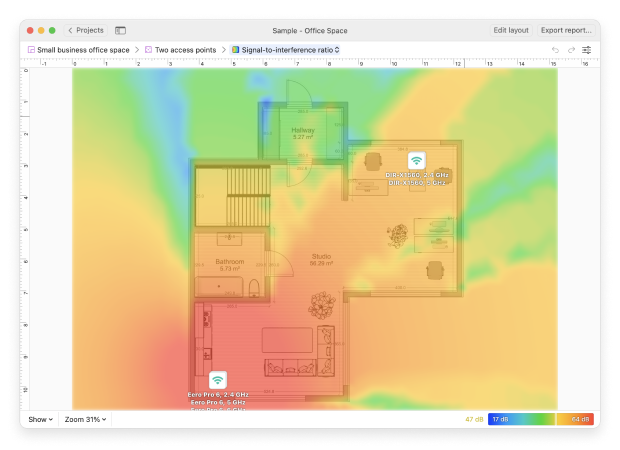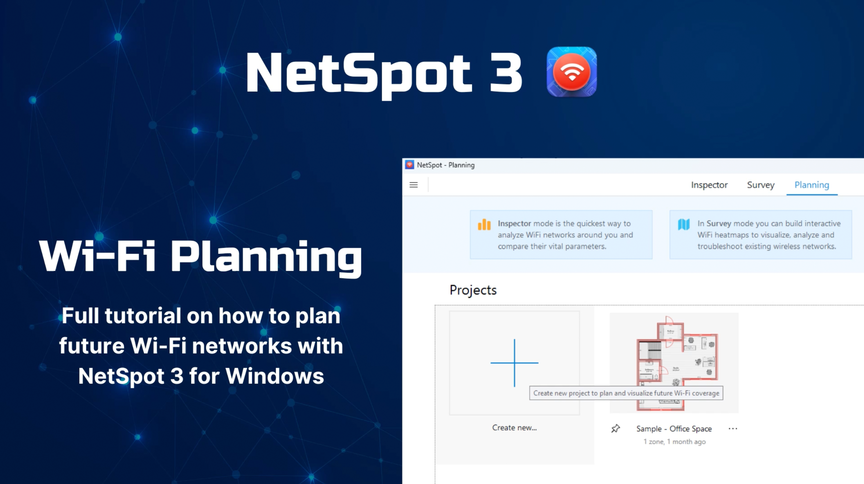Plan your Wi-Fi network with NetSpot Wi-Fi planning tool
Reliable Wi-Fi starts with Wi-Fi planning. A WiFi site survey helps optimize coverage, reduce interference, and ensure a stable connection for all your devices.
Small business owners realize how much more influence wireless local area networks (WLAN) have on every day of our lives now and how important it is to create the perfect working environment. In this article, we’ll show you how to plan a robust Wi-Fi network using NetSpot, covering everything from initial goals to final deployment.
Key Steps in Wi-Fi Planning
Assessing Wi-Fi Coverage and Capacity Goals
To start the wireless planning right, you'll need to set the coverage and capacity goals, create a predictive model that calculates how many access points (APs) you'll need and what their ideal placement should be, verify the accuracy of the WiFi planning predictions with the help of a manual site survey, and be ready to adjust as you go.
A good WiFi network plan is supposed to answer these questions:
- How many APs is the network going to need?
- What is the most efficient placement?
- What configuration for the access points will work best?
- What coverage and performance am I aiming at?
Tip: Striking the right balance with your access point count is essential. Adding too many can drive up costs and create interference issues, while too few may leave coverage gaps and slow performance. Weigh both coverage and capacity carefully to keep your network efficient and cost-effective.
With NetSpot WiFi planning tool — one of the best WiFi planning software tools — the aforementioned questions can be answered pretty precisely by creating a predictive design.
Assessing Environmental Factors
When planning to deploy a wireless network, think of how many clients it is going to serve, how heavy the traffic will be, how many access points it is going to need and where exactly, how much throughput you want the network to provide. Consider the following factors for successful implementation of a wireless network for your business:
Analyzing Physical Building Parameters
Before deploying a wireless network you should find out what your building is made of. Building materials like filled cinder blocks, brick, rock walls, or stucco construction are dense and can reduce the strength of your wireless signal.
Understanding these obstacles early in the Wi-Fi planning phase ensures optimal AP placement and coverage. Additionally, water-retaining structures such as pipes and bathrooms can impact signal range and should be considered in the wireless network planning phase.
Tip: For high-ceiling environments, consider adjusting antenna downtilt/uptilt positioning to improve coverage. AP placement and antenna angles can make a significant difference in reaching areas effectively.
In multi-story buildings, avoid placing APs directly above each other. Instead, stagger them in a zig-zag pattern to minimize interference and improve coverage consistency.
Balance the Load Accordingly
For effective wireless network planning, smaller or medium-sized businesses usually need less than 24 access points, but bandwidth is to be considered too. The proper bandwidth helps with productivity, while the properly managed access points with according load balance are important as well.
Tip: Utilizing centrally managed wireless controllers optimizes network performance and reduces administrative overhead.
When deciding on the type and number of APs to deploy consider the following:
- Simultaneous connections per SSID — How many devices will be sending and receiving traffic at the same time?
- Device capabilities — Are devices using WiFi 5, WiFi 6, or legacy standards?
- Application requirements — Will the network support bandwidth-intensive applications like video conferencing, VoIP, or cloud-based tools?
- User mobility — Are users frequently roaming between APs, requiring seamless handoffs?
- Minimum throughput needs — Define the baseline speed required per device for a smooth experience.
To gather this data, conduct a site survey by interviewing network users or distributing a questionnaire. For new deployments, estimate the number of concurrent users and devices in each zone. For existing networks, analyze real-time performance metrics using NetSpot’s network monitoring tool.
Even without exact numbers, creating a future-proof design is essential. Consider business growth projections — for example, if a retail store plans to implement mobile POS terminals, the network should support increased capacity without performance degradation.
For both new and existing deployments, regularly monitoring network activity and traffic patterns ensures optimal AP placement and bandwidth allocation. NetSpot enables real-time analysis of LAN and WLAN traffic, helping identify potential bottlenecks and signal interference.
When replacing an existing network, review historical performance data to pinpoint problematic areas. Address coverage gaps and optimize the network layout to eliminate past inefficiencies.
Lastly, understanding the wired infrastructure is equally important. The wireless network will integrate with switches, VLANs, and routers, so mapping out the wired topology ensures seamless operation and scalability.
Perform a Predictive Survey with WiFi Planning tool
With all the information that you now have about network goals and user categories, it is time to use a planning tool to estimate the number of access points needed and the correct placement for them.
The WiFi planner will estimate the optimal number of access points and will map the effective placement of the points based on the size of the covered area, types of APs that you have, the type of coverage, etc. You'll be able to see the power levels of transmission.
Tip: Use one map image per floor when designing a predictive model. Avoid placing multiple floors on a single map, as this can lead to inaccurate predictions and ineffective AP placement.
NetSpot offers two approaches to WiFi planning: Predictive Surveys and Single Hotspot Surveys. These methods provide a comprehensive, data-driven foundation for your wireless network planning, ensuring optimal placement of single or multiple hotspots.
Predictive survey allows you to accurately simulate your wireless network environment without physically setting up any hardware, significantly streamlining the WiFi planning process.
To start your predictive site survey using NetSpot, simply follow these steps:
Launch the latest version of NetSpot and activate Planning mode.
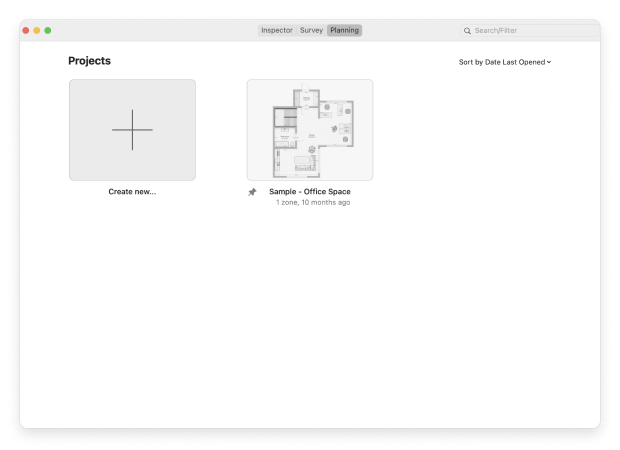
Create a new project and give it a descriptive name.

Load the map of your area from a file or create one using NetSpot’s built-in tools.
Calibrate the map by marking a known distance or area on the map layout, entering its real-life size or length.
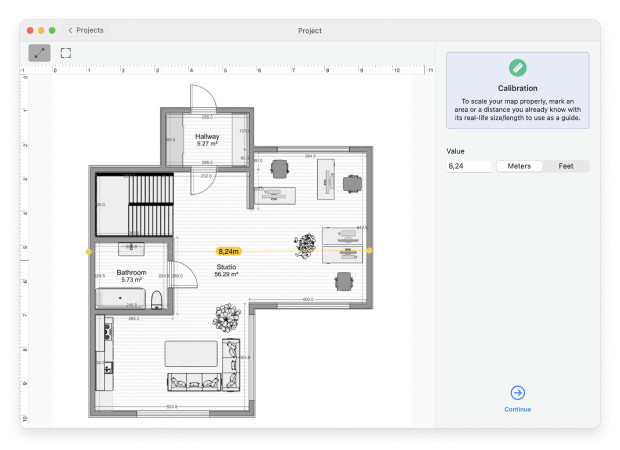
Add walls, windows, and doors, so that NetSpot has plenty of information to accurately simulate how different building materials will impact your WiFi signal. This is crucial for generating a reliable wireless network plan.
Tip: While detailed floor plans help, there’s no need to include every piece of furniture. Focus on walls, doors, and structural elements that impact signal propagation.
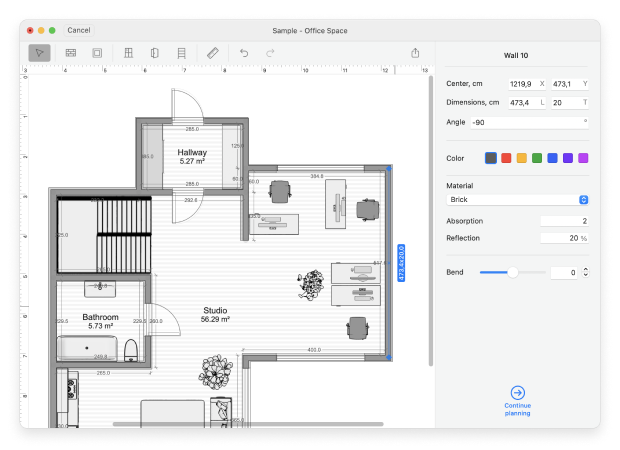
Add the virtual access points onto your calibrated map. If the AP you need appears in the list, simply select it; if not, just enter its specifications manually.
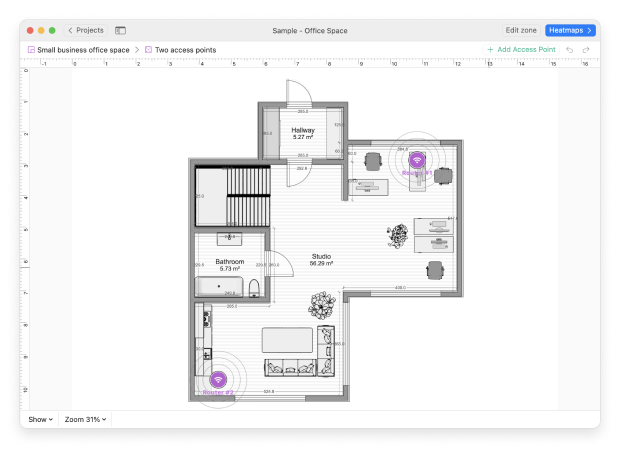
Analyze the generated heatmaps to decide if the virtual routers are placed correctly. If needed, adjust the positions of your virtual access points — simply drag the access points on the map to see what position gives you better coverage.
Tip: After completing an off-site predictive design, conduct pre-deployment and post-deployment site surveys with NetSpot to ensure your network meets real-world performance expectations.
Plan Future Wireless Networks with a Single Hotspot
For those experienced in network planning, you might have a good sense of where to place your access points. However, when it comes to large, complex networks spanning multiple floors, precise calculations are essential.
Such surveys are created by starting a new project in NetSpot and defining the area you wish to survey. After placing your hotspot in the initially chosen location, take multiple samples to create your first snapshot of the zone. It's crucial to then physically move the hotspot to another location within the survey area for additional sampling. Create new snapshots at each relocated hotspot position, covering different areas of your intended network layout.
After you've surveyed the entire area in this manner, NetSpot enables you to merge these individual snapshots, resulting in a comprehensive, unified network survey as if you had multiple access points deployed from the start.
This all-encompassing survey takes into account key variables such as the presence of neighboring WLANs, the impact of adjacent and co-channel interference, as well as electromagnetic signals from non-WiFi devices that could adversely affect the Signal-to-Noise Ratio (SNR) for devices on your wireless network.
Power Up
Now that you know how many WLAN access points your network will need, decide on the power requirements to support these points, typically 15 watts or less. Depending on the size of a business, the requirements will differ. Consider the power injectors option — they can be placed anywhere along the line within around 300 feet and will spare you the need for an external AC adapter.
WiFi Network Security and Safety
When a WiFi network lacks proper security measures, it becomes an open gateway for anyone to connect and potentially misuse. This is particularly concerning for business networks, where unauthorized access can lead to significant security risks. Implementing robust WiFi security protocols is essential for preventing such unauthorized connections.
Several different WiFi network security protocols are available, but they're not all equally effective. It's crucial to steer clear of outdated and insecure protocols like WEP (Wired Equivalent Privacy), which is now considered completely obsolete due to numerous security vulnerabilities.
WPA and WPA2 are far more secure than WEP, featuring a stronger encryption algorithm (AES 256 bit encryption). Wi-Fi Protected Access 3 (WPA3) is the latest security standard for wireless networks. With a more secure handshake protocol, individualized data encryption, and stronger password-based access, WPA3 is a significant upgrade in Wi-Fi security, and all users should enable it whenever possible.
Conduct site surveys before and after deployment
Note that a predictive survey won't count the neighboring WLANs co-channel interference, and the existence of electromagnetic signals from neighboring non-WiFi devices. To know more about these RF signals, a wireless site survey is to be done.
The real-time site survey will show you how accurate your predictive survey was within the architectural and RF environments. With all this data combined, you have all the information to design a better WiFi network that will meet and exceed expectations. If you're looking for specialized tools to facilitate this process, check out our list of the top WiFi site survey software currently available.
Keep the following tips in mind when performing a site survey:
- It would be ideal if a client was able to detect a signal of -70 dBm or better from one access point and another signal of -75 dBm or better from one or more other points. A client will firstly connect to an access point with a stronger signal and as it moves closer to a different AP and the signal there grows stronger the client can switch to the new AP. In case there are too many access points with equally strong signals then you can consider thinning them out or lower their Tx power.
With all the data you collected and analyzed you have enough means for designing the wireless network.
Common Wireless Networking Missteps
Ready to go online? Learn how to avoid some of the common wireless network perils:
This Access Point Worked at Home
Some wireless devices designed for home use may not be suitable for business environment, especially if the business is large. Home access points may cost cheaper but they were not made for a space bigger than a small home office and are usually meant for single deployments.
Stay on Point
Once you set everything up it is easy to become unconcerned. However you should keep in mind that technologies evolve quickly as well as hackers' possibilities. Keep your small business safe and unexposed to security risks, keep up with what's going on with the wireless market and where the technology is headed. Staying ahead of any possible risks will save time and money.
Leave Room to Grow
When you build a WLAN, don't just think about current needs, try to think about the future of your network, and prepare to grow with the technology. An advantage of wireless structures is that they are relatively easy to rearrange. Try to think through the business goals and needs in the future — choose the equipment and configuration accordingly.
A wireless network is no doubt an important asset to any business, but as with everything else you should always consider the objectives, limitations, the potential benefits as well as possible problems. Being aware of both advantages and disadvantages will keep the efficiency on the higher level and will make your wireless network a valuable asset to a successful business plan.
Conclusion
Planning a wireless network is an important task that can greatly influence your overall online experience. While this task might seem difficult, utilizing specialized Wi-Fi planning software like NetSpot can simplify the process. With NetSpot, you can effectively map out your coverage area, estimate the optimal number of access points, and identify potential issues in your wireless network plan before they become actual problems.
WiFi Planning — FAQ
The term Wi-Fi planning refers to the process of designing and configuring a wireless network to meet specific coverage, capacity, and performance goals. Typically, Wi-Fi planning is aided by specialized tools like NetSpot, which simplify the complex task of wireless network planning.
Network planning can be broadly divided into the following sub-types:
- Predictive network planning: Involves using software tools to create a virtual model of the intended network environment.
- Post-deployment survey: Conducted after the network has been set up, this survey verifies if the network meets the initial design specifications and goals.
- Real-time network monitoring: The ongoing analysis of an active network to ensure its optimal operation.
To plan your Wi-Fi coverage, you can start by performing a predictive site survey to simulate how your wireless network will behave in a specific environment. This involves creating a virtual layout of the area where you intend to deploy the network, marking potential access point locations, and setting performance goals.
Estimate how many clients are going to connect to the deployed network, how much traffic is it going to need, and size up your space to see how many access points you might be installing.
To perform a WiFi site survey, use a WiFi planner tool like NetSpot. It can help you estimate the optimal amount of access points and will map out their efficient placement. The visual map is very helpful as you'll be able to drag the access points and see how their positions affect your wireless coverage.
A manual site survey benefits you in many ways: with the data collected you can easily create a better wireless network that will meet and exceed the expectations. When performing a manual site survey, keep the following in mind:
- For data services, the wireless devices on the network should have a minimum RSSI of -70 dBm and an SNR of at least 20 dB. For voice and video connection, aim for RSSI of at least -67dBm and SNR of at least 23 dB.
- You want a sufficient amount of access points in your network with strong signal. You don't need to overcrowd your space with APs however. An optimal AP placement will help you save money and build an even coverage.
- Using an access point not suitable for a specific environment. What works well for a private home network, might fail in a large business environment.
- Placing access points without any strategy. Perform a WiFi survey with NetSpot to determine optimal placement and number of devices.
- Not staying in the know. It is not just setting up the network that keeps it functioning well, it is also proper maintenance. Keep your business safe and unexposed to security risks, keep up with what's going on with the wireless market and where the technology is headed. Staying ahead of any possible risks will save time and money.
- Not thinking ahead. Don't just think about your immediate needs when setting up a network, try to think how it will develop and what your business might need from it in the future.
